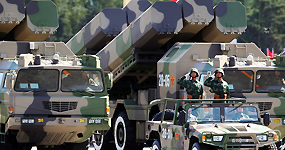
美国海军一名高级将领称,中国的一种新式反舰导弹可以投入使用,这种导弹将极大地改变太平洋地区的军事力量平衡。
美军太平洋司令部司令罗伯特•威拉德上将(Admiral Robert Willard)在接受日本报纸《朝日新闻》(Asahi Shimbun)采访时表示,中国这种弹道导弹已具备“初步作战能力”。这种导弹旨在威胁太平洋地区的美国航空母舰。
他的上述言论表明,中国对美国在亚洲投射军力之能力的挑战,来得比许多人预计的要快许多。
美国及太平洋地区其它国家对中国海军实力的发展速度日渐关切。
美国海军战争学院(US naval war college)中国军事专家安德鲁•埃里克森(Andrew Erickson)在回应威拉德上将的言论时表示:“现在我们知道了,中国的[反舰弹道导弹]已不再只是个梦想。”
国防分析人士称东风-21D导弹为“游戏规则改变者”,因为该导弹可以阻止美国航母进入中国不希望它们进入的水域。
这种路基导弹旨在借助卫星、无人驾驶飞机和超视距雷达来攻击航母群。
美国国防部长罗伯特•盖茨(Robert Gates) 9月份表示,这种导弹的研发将迫使美国国防部重新考虑航母的部署方式。
盖茨问道:“如果中国人或其他什么人拥有一种高精度反舰巡航或弹道导弹,能摧毁数百英里射程内的航母,以此在亚洲让我们退回到第二岛链后面,那么,你在未来该如何改变航母的使用?”
第二岛链自小笠原群岛算起,沿马里亚纳群岛和关岛一路延伸到帕劳群岛,在日本和菲律宾以东构成一条南北走向的岛链。该岛链以内水域被中国视为其“近海”——目前美国海军在这片水域频繁开展军事活动,这里也是美国海军基地和盟国所在地。
威拉德上将在今年早些时候透露,中国的反舰弹道导弹正在接受广泛的测试,已接近部署阶段。观察人士认为,中国去年就开始生产导弹发动机,目前正准备在南部城市韶关部署一个核导弹基地。
美国国防部所使用的术语“初步作战能力”意味着,一些军事单位已开始部署该武器,并已具备使用能力。
威拉德上将表示,中国这种新式武器尚未具备可完全投入使用的性能,很可能还需要“数年”的测试。剩下的关键一步是在海上测试整个系统。
译者/何黎
http://www.ftchinese.com/story/001036250

A new Chinese anti-ship missile that will significantly alter the balance of military power in the Pacific is operational, according to a senior US commander.
Admiral Robert Willard, the US commander in the Pacific, said the Chinese ballistic missile, which is designed to threaten US aircraft carriers in the region, had reached “initial operational capability”.
His remarks signal that China is challenging the US ability to project military power in Asia much sooner than many had expected.
The US and other countries in the Pacific region are increasingly concerned at the speed with which China is developing its naval power.
“So now we know – China’s [anti-ship ballistic missile] is no longer aspirational,” Andrew Erickson, a Chinese military expert at the US Naval War College, said in response to Adm Willard’s comments to the Asahi newspaper.
Defence analysts have called the Dongfeng 21D missile a “game changer” since it would discourage US aircraft carriers from entering waters where China does not want them.
The land-based missile is designed to target aircraft carrier groups with the help of satellites, unmanned aerial vehicles and over-the-horizon radar.
In September, Robert Gates, US defence secretary, said the development of such a missile would force the Pentagon to rethink the way carriers are deployed.
“If the Chinese or somebody else has a highly accurate anti-ship cruise or ballistic missile that can take out a carrier at hundreds of miles of ranges and therefore in Asia puts us back behind the second island chain, how then do you use carriers differently in the future?” Mr Gates asked.
The second chain of islands runs from the Bonins along the Marianas, Guam and Palau, forming a north-south line east of Japan and the Philippines. This line defines what China sees as its “near seas” – waters in which the US navy now frequently operates and are home to US naval bases and allies.
Adm Willard revealed earlier this year that China’s ASBM was undergoing extensive testing and was close to deployment. Observers believe China started production of missile motors last year and that it is preparing a nuclear missile base in the southern city of Shaoguan for their deployment.
The term “initial operational capability” as used by the Pentagon indicates that some military units have started deployment of the weapon and are capable of using it.
Adm Willard said the new Chinese weapon was not fully operational and would probably undergo testing for “several more years”. The key remaining step is a test of the entire system at sea.
没有评论:
发表评论